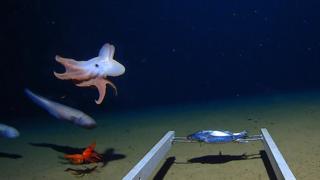 Image copyright A.Jamieson
Image copyright A.Jamieson The deepest ever sighting of an octopus has been made by cameras on the Indian Ocean floor.
The animal was spotted 7,000m down in the Java Trench – almost 2km deeper than the previous reliable recording.
Researchers, who report the discovery in the journal Marine Biology, say it’s a species of “Dumbo” octopus.
The name is a nod to the prominent ear-like fins just above these animals’ eyes that make them look like the 1940s Disney cartoon character.
The scientist behind the identification is Dr Alan Jamieson.
He’s pioneered the exploration of the deep using what are called “landers”.
These are instrumented frames dropped overboard from research ships.
They settle on the seabed and record what passes by.
Dr Jamieson’s equipment filmed two octopuses – one on a drop to 5,760m and a second to 6,957m. The individual animals were 43cm and 35cm in length.
They’ve been placed in the Grimpoteuthis family – the group commonly known as Dumbo.
Octopus fragments and eggs have been found at very great depths, but until this discovery, the previous deepest reliable sighting was at 5,145m down.
That was a black and white photo of an animal taken 50 years ago in the Caribbean.
The significance of the Indian Ocean observations is that we now know that octopuses can find potentially suitable habitat across at least 99% of the global seafloor. But those animals that do live at depth will clearly need some special adaptations, says Dr Jamieson.
“They’d have to do something clever inside their cells. If you imagine a cell is like a balloon – it’s going to want to collapse under pressure. So, it will need some smart biochemistry to make sure it retains that sphere,” the scientist explained.
“All the adaptations you need to live at pressure are at the cellular level.”
Dr Jamieson recorded the new octopus while working as chief scientist on the Five Deeps Expedition. This was the project that saw Texan financier Victor Vescovo take a submersible to the deepest sectors of the five major oceans on Earth.
While Mr Vescovo was setting human dive records, Dr Jamieson was conducting the tandem science investigations.
He hopes his findings can help dispel some of the misunderstandings about the deepest parts of the ocean.
“The laws of marine ecology and marine biology are actually much the same. And we need the Dumbo octopus out there to blur that line between the depths we think we care about and the depths we don’t. This idea that only animals in a kind Victorian freak show live at depth isn’t right.”
Dr Jamieson is currently the CEO of Armatus Oceanic, a deep-sea consultancy. He’s also affiliated to Newcastle University.
Jonathan.Amos-INTERNET@bbc.co.uk and follow me on Twitter: @BBCAmos


